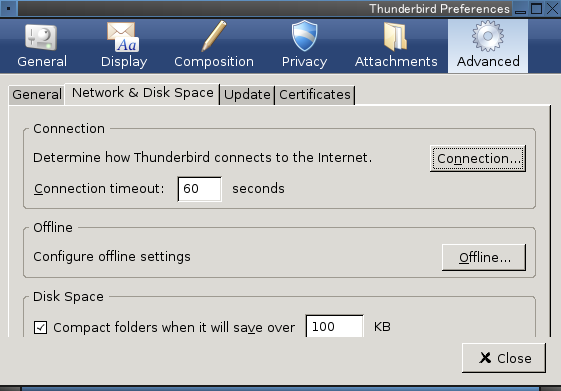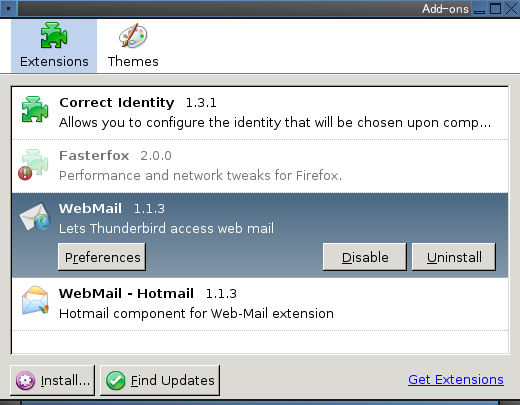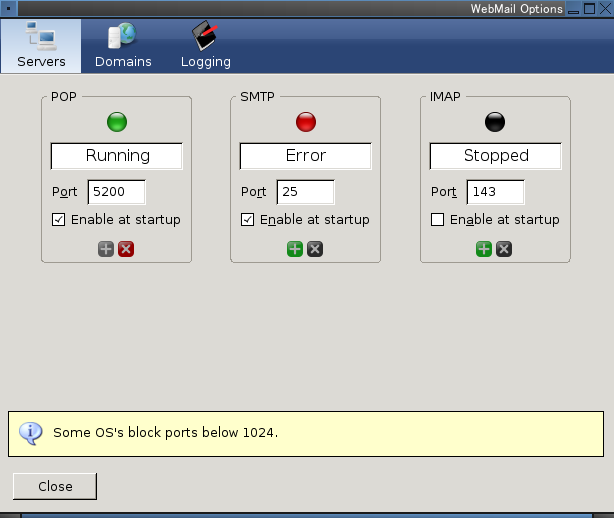
Thunderbird's installation is mentioned here. While Thunderbird is pretty usuable after a fresh install, this page contains some tips and add-ons for getting more out of Thunderbird.
Opening hyperlinks in Firefox
Permanently removing deleted messages to recover disk space
Downloading webmail (Hotmail, Yahoo!, AOL, etc.) directly into Thunderbird
By default, clicking hyperlinks contained in the body of e-mails will not do anything. If you want Firefox to open the link by default, you can follow these instructions:
First, make sure you're not running Thunderbird. If you are, exit it. Then, as your user. . .
cd ~/.thunderbird
Look for a directory that starts with random letters and numbers and ends with ".default". On my system this directory is called "63js5cca.default", so that's what I'll use in this example. Change according to your needs:
vi 63js5cca.default/user.js
Unless you've already did some user customizations to Thunderbird, this will probably create a new file. Add the following lines:
user_pref("network.protocol-handler.app.http", "/usr/local/bin/firefox");
user_pref("network.protocol-handler.app.https", "/usr/local/bin/firefox");
user_pref("network.protocol-handler.app.ftp", "/usr/local/bin/firefox");
Save your changes and exit. The next time you launch Thunderbird, the new behavior should take effect. Test it out by clicking a URL contained in an e-mail and see what happens.
Permanently removing deleted e-mails to recover disk space
Although you might delete messages you no longer need, Thunderbird continues to store this information. Run the following command (substituting the random "garble".default that will exist in your Thunderbird settings) and you'll see what I mean:
ls -lh ~/.thunderbird/nl3igyz0.default/Mail/Local\ Folders/
You'll see a list of files, including "Inbox" and "Sent". I don't keep e-mails after I've replied to them, so my Thunderbird Inbox normally has no more than 20 messages in it depending on how behind I am at replying to people. However, after 3 years of use, my Inbox file was over 1 GB in size!
In order to recover this disk space (and permanently remove messages you've deleted), right-click on high-volume folders such as Inbox and Sent within Thunderbird and select the option "Compact This Folder". The e-mails currently in the folder will remain untouched, but those e-mails you've deleted will be permanently removed. In my case, this freed up over 1 GB of disk space. The (dis)advantage is that once you've done this, previously deleted e-mails will no longer be recoverable.
Compact your folders in Thunderbird in this fashion from time to time if you're concerned about disk space or deleted messages being recovered. As of thunderbird-2.0, it is now possible to set Thunderbird to automatically do this for you. (This option already existed in thunderbird-1.5 on Mac OS X).
In Thunderbird, select the Edit > Preferences menu. A preferences window will appear. Click on the "Advanced" icon (top-right icon), then click on the "Network & Disk Space" tab. Check the box under Disk Space that says "Compact folders when it will save over ____ KB"

Now Thunderbird will automatically compact folders to recover disk space. The first time this occurs, a pop-up window will ask you to confirm whether you want to compact the folder(s), and you can select an option not to display that warning anymore in the future. Very convenient, but remember, once you delete a message and empty the Trash folder, the message will be permanently removed.
Downloading webmail (Hotmail, Yahoo!, AOL, etc.) directly into Thunderbird
With a combination of useful add-ons, it is possible to download your e-mail messages from webmail accounts such as Hotmail or Yahoo! directly into Thunderbird. The add-ons we're about to install apparently "fool" the webmail server into thinking that you are logging into your account normally, when in fact the add-on is automatically retrieving and downloading your webmail e-mail messages to Thunderbird.
First, visit http://webmail.mozdev.org/installation.html. Right-click on the link for "Web-Mail-1.1.4 (TB 2.0)" and choose "Save Link As...". The version number of Web-Mail is not important; what is important is that the parenthetical "TB #.#" matches the version of Thunderbird you're running.
Once you've downloaded the add-on, go to the Tools > Add-ons menu in Thunderbird. A new window will appear. Click the "Install..." button in the bottom-left corner of the window. Then, select the file that you just downloaded. (It'll be named something like "web-mail-1-1-4.xpi"). Click "Open", then click "Install" in the following window. (The button will start out grayed-out, but after a few seconds you should be able to click it). When the installation is finished, click the "Restart" button to restart Thunderbird and complete the install.
Once you're back in Thunderbird, go to the Tools > Add-ons menu, click on WebMail (under Extensions, which should be displayed by default), and click the "Preferences" button.

The following window will then appear:

Under "Servers," which should be displayed by default, POP, SMTP, and IMAP will probably all be red and "Error" should be displayed. To fix this for POP, edit the box next to "Port," replacing the default with "5200" as shown in the above screenshot.
Then click the green "+" button underneath the check box that says "Enable at startup." You should see a message about the server starting and the light should turn green and the "Error" message will be replaced with "Running." Click "Close" to quit the Web-Mail options.
NOTE: I didn't enable SMTP in my Web-Mail extension, because I don't need to use, i.e. Hotmail, for SMTP access. However, I tested SMTP by setting the port to "5201" and got it to work, so feel free to do this if you need to send from, i.e. Hotmail rather than using the SMTP server provided by your ISP.
Now go back to http://webmail.mozdev.org/installation.html and install the extension that corresponds to your webmail account. For example, if you have a Hotmail account that you want to use with Thunderbird, download "Hotmail-1.1.3 (TB 2.0)" or its equivalent. Installation is the same as for the Web-Mail extension: from within Thunderbird, go to the Tools > Add-ons menu in Thunderbird. A new window will appear. Click the "Install..." button in the bottom-left corner of the window. Then, select the file that you just downloaded. (It'll be named something like "hotmail-1-1-3.xpi"). Click "Open", then click "Install" in the following window. (The button will start out grayed-out, but after a few seconds you should be able to click it). When the installation is finished, click the "Restart" button to restart Thunderbird and complete the install.
Now all that's left to do is add our Hotmail account to Thunderbird. Go to the Edit > Account Settings..." menu and then click "Add Account..." (This is the top of the 3 options in the bottom-left corner of the Account Settings window that will appear). Choose "Email account, then click the "Next" button. Enter the name you want to appear when you send e-mail to people, then enter your Hotmail address. Click the "Next" button.
This next step is important. Make sure "POP" is selected for the type of incoming server, then next to "Incoming Server:" type "localhost" (omitting the quotation marks). Whether or not you want to Use Global Inbox is purely a matter of personal preference. I do, but that doesn't mean you have to. Click the "Next" button. For "Incoming User Name:", enter your entire Hotmail address, i.e. your username AND the @hotmail.com. If you leave out the @hotmail.com, it won't work. Click the "Next" button. Under "Account Name:" you may want to name the account something intuitive like "Hotmail." Click the "Next" button, then, if you're satisfied with the summary, click the "Finish" button.
Now, in the left-hand box displaying your accounts in the "Account Settings" menu, you should see "Hotmail" as an option. Click on the "Server Settings" branch underneath "Hotmail," and you should see something like this:

Change "Port" to "5200" or Hotmail will not work. Under Security Settings, make sure "Use secure connection:" is set to "Never" and the "Use secure authentication" box is not checked. Whether or not you want Thunderbird to check for new messages on startup, check for new messages periodically, empty the trash on exit, etc., are purely a matter of personal preference. When you're finished, click the "OK" button to exit your account settings.
Moment of truth: click the "Get Mail" button in the top-left corner of thunderbird, and Thunderbird should attempt to login to Hotmail and download your e-mail messages. The first time, a pop-up window will appear asking you for your password. It is up to you if you want Thunderbird to remember your password (in which case you won't have to type it in anymore) or not.